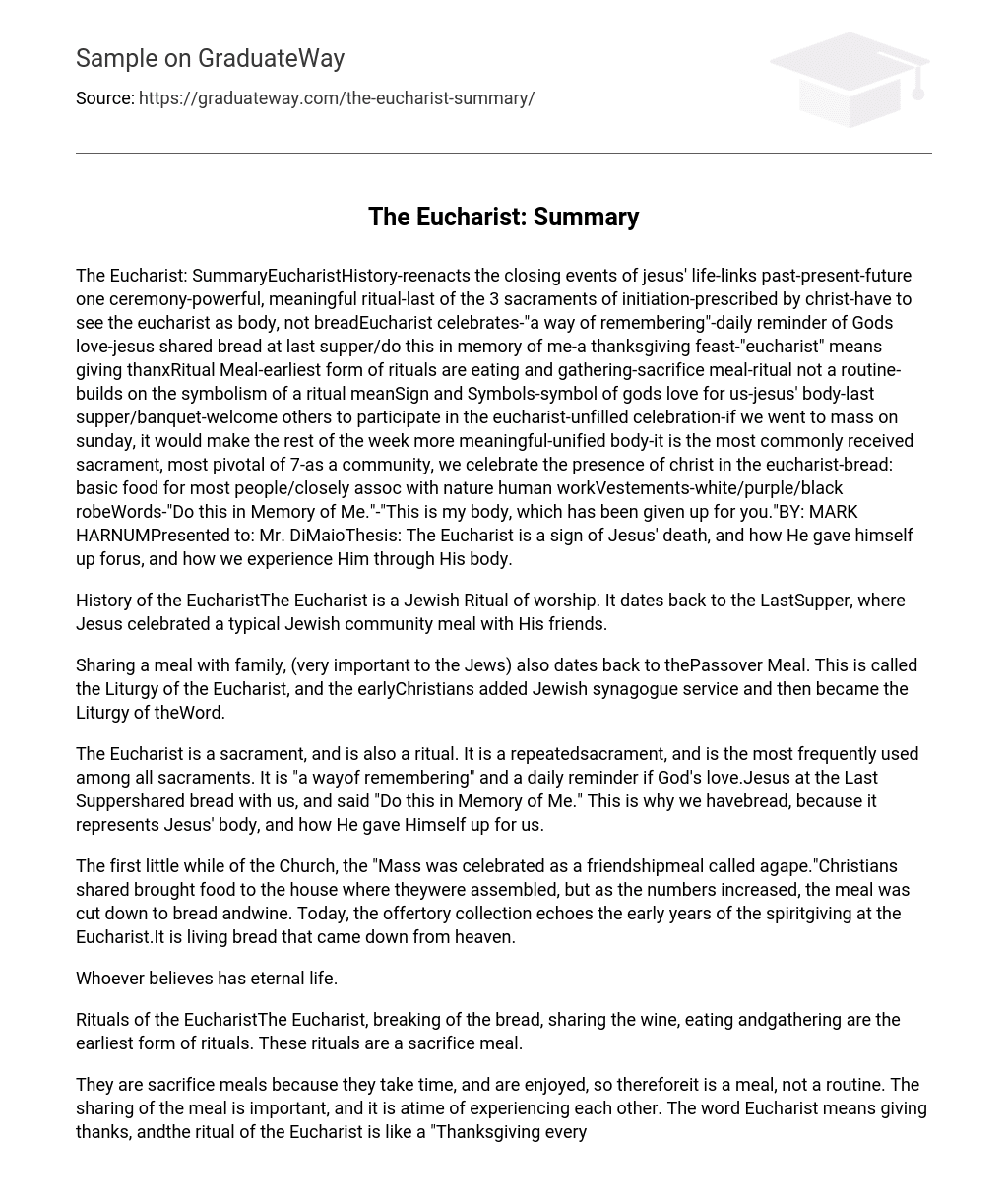The Eucharist: SummaryEucharistHistory-reenacts the closing events of jesus’ life-links past-present-future one ceremony-powerful, meaningful ritual-last of the 3 sacraments of initiation-prescribed by christ-have to see the eucharist as body, not breadEucharist celebrates-“a way of remembering”-daily reminder of Gods love-jesus shared bread at last supper/do this in memory of me-a thanksgiving feast-“eucharist” means giving thanxRitual Meal-earliest form of rituals are eating and gathering-sacrifice meal-ritual not a routine-builds on the symbolism of a ritual meanSign and Symbols-symbol of gods love for us-jesus’ body-last supper/banquet-welcome others to participate in the eucharist-unfilled celebration-if we went to mass on sunday, it would make the rest of the week more meaningful-unified body-it is the most commonly received sacrament, most pivotal of 7-as a community, we celebrate the presence of christ in the eucharist-bread: basic food for most people/closely assoc with nature human workVestements-white/purple/black robeWords-“Do this in Memory of Me.”-“This is my body, which has been given up for you.”BY: MARK HARNUMPresented to: Mr. DiMaioThesis: The Eucharist is a sign of Jesus’ death, and how He gave himself up forus, and how we experience Him through His body.
History of the EucharistThe Eucharist is a Jewish Ritual of worship. It dates back to the LastSupper, where Jesus celebrated a typical Jewish community meal with His friends.
Sharing a meal with family, (very important to the Jews) also dates back to thePassover Meal. This is called the Liturgy of the Eucharist, and the earlyChristians added Jewish synagogue service and then became the Liturgy of theWord.
The Eucharist is a sacrament, and is also a ritual. It is a repeatedsacrament, and is the most frequently used among all sacraments. It is “a wayof remembering” and a daily reminder if God’s love.Jesus at the Last Suppershared bread with us, and said “Do this in Memory of Me.” This is why we havebread, because it represents Jesus’ body, and how He gave Himself up for us.
The first little while of the Church, the “Mass was celebrated as a friendshipmeal called agape.”Christians shared brought food to the house where theywere assembled, but as the numbers increased, the meal was cut down to bread andwine. Today, the offertory collection echoes the early years of the spiritgiving at the Eucharist.It is living bread that came down from heaven.
Whoever believes has eternal life.
Rituals of the EucharistThe Eucharist, breaking of the bread, sharing the wine, eating andgathering are the earliest form of rituals. These rituals are a sacrifice meal.
They are sacrifice meals because they take time, and are enjoyed, so thereforeit is a meal, not a routine. The sharing of the meal is important, and it is atime of experiencing each other. The word Eucharist means giving thanks, andthe ritual of the Eucharist is like a “Thanksgiving every day of the year”.
Symbols of the EucharistThe Eucharist is a symbol of God’s love for us. It illustrates Jesus’sbody, and welcomes others to participate in the Eucharist. The Eucharist is anunfilled Celebration and receiving the Eucharist on Sunday, makes the rest ofthe week more meaningful. It symbolizes the unified body of Christ, and thechurch symbolizes a community as we celebrate the presence in Christ in theEucharist. The bread symbolizes giving thanks, and is the basic food for mostpeople and is closely associated with nature and work of human hands. Sharingthe Cup represents that drink is essential to life and both bread and wine aresymbols of Christ. It also symbolizes how we can go forty days without water asopposed to five days without water. Proclaiming the Word of God means thatJesus is present in the Gospels and He comes alive for us in hearing the wordsand stories of his life. We stand to welcome Christ into our living word of God.
VestmentsThe garments worn during the Eucharist at Church are either Black, White,or Purple. These are for different times of the year. Black symbolizes death,purple illustrates Advent, and white portrays ordinary time.
Words, Statements, ResponsesThere are many different expressions used in the Mass, all withimportant meanings. First, the priest prepares the gifts, to make them Holy.
We respond “Blessed it be God forever.” Another one is “Do this in Memory ofMe.” This means that Jesus gave Himself up for us, and wants us to remember whatHe did for us. It reenacts the closing events of Jesus’ life on earth.Thisis followed by the Eucharist Prayer “Holy, Holy, Holy Lord…” then ensued by”Lord, I am not worth to receive you, but only say the word, and I shall behealed.” This means to clean yourself of sins, and get ready for the body ofChrist. To ask God if He welcomes you to receive the Eucharist.
BIBLIOGRAPHYCOOKE, Bernard, THE EUCHARIST, “Mystery of Friendship” Centre of Studies inReligious Education Ohio, 1969.
GUZIE, Tad, W. JESUS AND THE EUCHARIST, Paulist Press New York, 1974RELIGION MANUAL p: 117-131JOHN 6: 47-58, BIBLELUKE 22: 14-20 BIBLEGIFTS OF THE HOLY SPIRIT, HandoutLITURGY OF THE WORD, HandoutWHAT IS THE SACRAMENT, HandoutHistory





